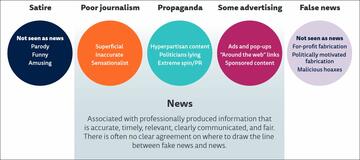
The Factsheet of the Reuters Institute for the Study of Journalism analyses data from the first half of 2017 from the United States, the United Kingdom, Spain and Finland to understand audience perspectives on fake news. It adopts a mix of qualitative and quantitative data from these countries, including data from 8 focus groups and data from a survey of online news users.
The results of the study highlights a wide discontent with the information landscape - including news media and politicians as well as platform companies - which is concurrent to a widespread crisis of confidence towards public institutions in many countries. This fact, together with the changing media environment, offers the backdrop for discussions around fake news.
Although perceptions on fake news differ not only from country to country but also among interviewees of the same country, there are a number of common patterns:
- The difference between real and fake news emerges primarily as a matter of degree and there is no clear agreement on where to draw the line between the two.
- Poor journalism, political propaganda - including the way journalists cover politics - and some advertising are considered by people as the main forms of fake news, while publishers, platforms, and politicians are associated with it.
- Despite the fact that a number of media are defined as a credible source of information there is no generalised consensus on which outlets to trust.
- Finally, many people consider the term fake news as a politicized buzzword.
The findings of the Factsheet suggest that the issue of fake news needs to be tackled taking also into account the audience’s perspective on it.
Tags: Fake news and disinformation Trust in media Freedom of expression Media freedom Access to information Finland United Kingdom SpainThe content of this article can be used according to the terms of Creative Commons: Attribution-NonCommercial 4.0 International (CC BY-NC 4.0) . To do so use the the wording "this article was originally published on the Resource Centre on Media Freedom in Europe" including a direct active link to the original article page.

